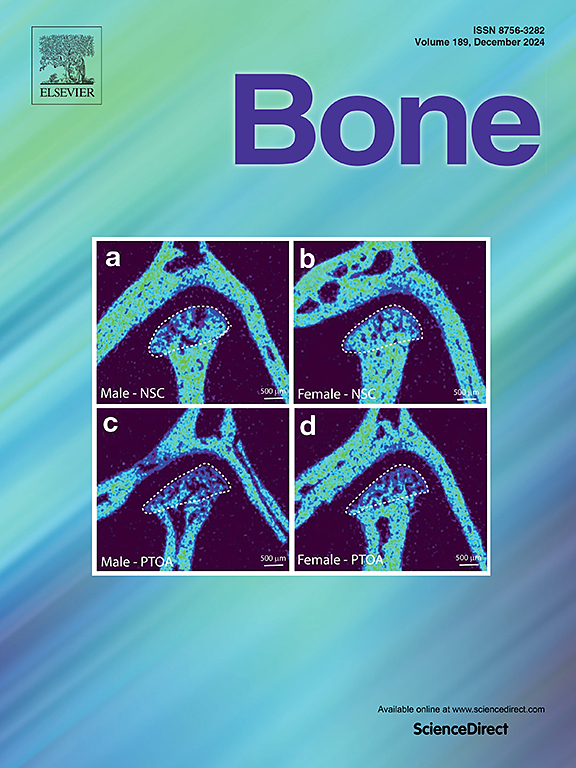减肥手术后的骨质流失主要发生在髋关节小梁区和采用低吸收技术后。
IF 3.5
2区 医学
Q2 ENDOCRINOLOGY & METABOLISM
引用次数: 0
摘要
我们使用双能 X 射线吸收测量法(DXA)、骨小梁评分法(TBS)和 3D-DXA 评估了减肥手术一年来对骨矿物质密度(BMD)和微结构的影响,以评估不同手术技术后的变化。这项前瞻性、单中心研究针对 153 名重度肥胖症患者,对比了袖状胃切除术(SG)、Roux-en-Y 胃旁路术(RYGB)和十二指肠转换/单吻合十二指肠回肠造口术加袖状胃切除术(DS/SADIS)对骨骼健康的影响。据我们所知,这是第一项对接受 DS/SADIS 手术的患者进行评估,并将 3D-DXA 分析纳入骨质流失评估的研究。患者中 81% 为女性,平均年龄为 50 ± 9 岁。54%的患者接受了 SG;16%接受了 RYGB;30%接受了 DS/SADIS。我们的研究结果显示,减肥手术一年后,LS(-3.49 ± 5.44 %)、FN(-5.24 ± 5.86 %)和TH(-8.06 ± 5.14 %)处的骨密度值明显下降。通过 TBS 评估,30% 的患者 LS 处的骨微结构退化。股骨近端 3D-DXA 分析显示,手术引起的骨质流失主要影响骨小梁区(骨小梁容积 (v) BMD:-8.00 ± 6.57 %),而非皮质区(皮质 vBMD:-1.37 ± 2.79 %)。这些结果表明,与限制性技术(SG)相比,低吸收性和混合性技术(DS/SADIS 和 RYGB)与更大的 BMD 损失和微结构恶化相关。骨密度和微结构损伤的主要决定因素是体重减轻程度和手术类型。尽管总体骨质流失,但 Z 值评估表明,与健康人群相比,手术后的骨质状况仍在平均范围内或高于平均范围,但 DS/SADIS 术后的 TH 除外。总之,我们的研究显示了减肥手术技术对骨密度和微结构影响的差异,强调了术后仔细监测骨健康的必要性,尤其是对接受低吸收手术和混合手术的患者。本文章由计算机程序翻译,如有差异,请以英文原文为准。
Bone loss after bariatric surgery is observed mainly in the hip trabecular compartment and after hypoabsorptive techniques
We evaluated the impact of bariatric surgery on bone mineral density (BMD) and microarchitecture over one year using dual-energy X-ray absorptiometry (DXA), the trabecular bone score (TBS), and 3D-DXA to assess changes after different surgical techniques. This prospective, single-center study of 153 patients with severe obesity contrasts the effects on bone health of sleeve gastrectomy (SG), Roux-en-Y gastric bypass (RYGB), and duodenal switch/single anastomosis duodeno-ileostomy with sleeve gastrectomy (DS/SADIS). To our knowledge, this is the first study to evaluate patients undergoing DS/SADIS and to incorporate 3D-DXA analysis in the assessment of bone loss.
Patients were 81 % female with a mean age of 50 ± 9 years. Fifty-four per cent underwent SG; 16 %, RYGB; and 30 %, DS/SADIS. Our findings revealed a significant decrease in areal BMD at the LS (−3.49 ± 5.44 %), FN (−5.24 ± 5.86 %), and TH (−8.06 ± 5.14 %) one year after bariatric surgery. Bone microarchitecture at the LS assessed by TBS was degraded in 30 % of patients. Proximal femur 3D-DXA analysis showed that surgery-induced bone loss predominantly affects the trabecular compartment (Trabecular volumetric (v) BMD: −8.00 ± 6.57 %) rather than the cortical compartment (Cortical vBMD: −1.37 ± 2.79 %).
These results suggest hypoabsorptive and mixed techniques (DS/SADIS and RYGB) were associated with greater BMD loss and deterioration of microarchitecture than restrictive techniques (SG).
The primary determinants of bone density and impairment of microarchitecture were the extent of weight loss and the type of surgical procedure. Despite overall bone loss, Z-score assessments indicated that post-surgical bone status remained within or above the average ranges compared to a healthy population, except for TH following DS/SADIS.
In conclusion, our research shows differences in the impact of bariatric surgery techniques on bone density and microarchitecture, emphasizing the need for careful postoperative monitoring of bone health, particularly in patients undergoing hypoabsorptive and mixed procedures.
求助全文
通过发布文献求助,成功后即可免费获取论文全文。
去求助
来源期刊

Bone
医学-内分泌学与代谢
CiteScore
8.90
自引率
4.90%
发文量
264
审稿时长
30 days
期刊介绍:
BONE is an interdisciplinary forum for the rapid publication of original articles and reviews on basic, translational, and clinical aspects of bone and mineral metabolism. The Journal also encourages submissions related to interactions of bone with other organ systems, including cartilage, endocrine, muscle, fat, neural, vascular, gastrointestinal, hematopoietic, and immune systems. Particular attention is placed on the application of experimental studies to clinical practice.
 求助内容:
求助内容: 应助结果提醒方式:
应助结果提醒方式:


